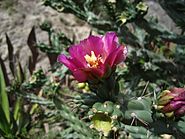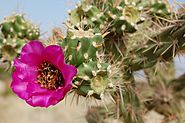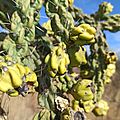Cane cholla facts for kids
Quick facts for kids Cane cholla |
|
|---|---|
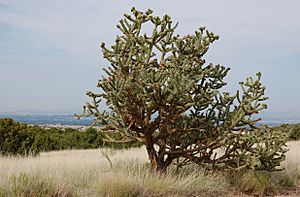 |
|
| Scientific classification | |
| Genus: |
Cylindropuntia
|
| Species: |
imbricata
|
| Synonyms | |
|
Opuntia imbricata |
|
The cane cholla (Cylindropuntia imbricata) is a unique type of cactus. People also call it the walking stick cholla or tree cholla. You can find this plant in the Southwestern United States and northern Mexico. Unlike many cacti, it can even grow in slightly cooler areas.
This cactus is easy to spot because it often grows like a large shrub or even a small tree. It has a distinct shape and produces yellowish fruits that stay on the plant for a long time.
Contents
Where the Cane Cholla Grows
The cane cholla lives in dry, desert-like areas. Its natural home stretches across Nevada, Arizona, New Mexico, Colorado, Oklahoma, and Texas in the U.S. It also grows south into parts of Mexico, including Durango, Zacatecas, and San Luis Potosí.
- This cactus can grow at high elevations, from about 3,900 to 7,500 feet (1,200 to 2,300 meters) above sea level.
- It's quite tough for a cactus and can survive in colder temperatures than many other types.
In some places, especially just below the areas where pinyon and juniper trees grow, the cane cholla can be very common. It often stands out as the only tall green plant among low grasses and other small plants that are brown for most of the year. These cacti might grow close together, forming thick groups, or they can be spread out like plants in a "garden."
When the Cane Cholla Becomes a Problem
In Australia, the cane cholla is considered a harmful plant that spreads too much. It's known there as the Devil's rope cactus or Devil's rope pear. It has invaded old mining sites and areas along rivers. This cactus is officially listed as a noxious weed in New South Wales and is also found in Queensland, Northern Territory, Victoria, and South Australia.
What the Cane Cholla Looks Like
The cane cholla has many branches made of cylindrical stems. The newest parts of the stems are about 1.2 inches (3 cm) thick. Unlike some other chollas, these stem pieces are hard to break off. The stems have many bumps, which look like long oval lumps.
- A typical cane cholla is about 3 feet (1 meter) tall.
- Some can grow much taller, up to 15 feet (4.6 meters), with a "trunk" about 10 inches (25 cm) wide.
- The plant's width is usually similar to or a bit wider than its height.
The stems are covered with clusters of sharp spines. There can be up to 10 spines in a cluster, and they are usually red to pink. These spines can be 1.2 inches (3 cm) long and are barbed, meaning they have tiny hooks. They are sharp enough to easily go through leather gardening gloves! The stems and fruits also have many tiny spines called "glochids," which are about 0.04 inches (1 mm) long. These can easily break off and stick in your skin.
Stems and Flowers
The cane cholla has two main types of stems:
- Flowering stems: These grow outwards and have flowers at their ends. They usually fall off after a few years.
- Support stems: These grow upright and help support the plant. They stay on the plant for a long time.
The flowering stems grow in a star-like shape around the central support stems.
This cactus blooms in late spring or early summer. Its flowers are usually purple or magenta, but sometimes they can be rose-pink. Each flower is about 2 inches (5 cm) wide.
Fruits of the Cane Cholla
The fruits of the cane cholla are yellowish and bumpy, just like the stems. They are shaped a bit like a cone with a hollow at the wider end where the flower used to be. People often mistake these fruits for flowers because they stay on the plant all winter long.
The fruits are dry and not very tasty. However, some Native American groups in Arizona and New Mexico are said to have eaten them in the past.
How the Cane Cholla Reproduces
Besides making seeds from its flowers, the cane cholla can also reproduce in another way. If a piece of its stem breaks off and falls to the ground, it can take root and grow into a new plant.
This makes the cane cholla very good at spreading, and it can be hard to control its growth. Animals like cows can help spread it by eating the fruits (even though they are spiny) and then dropping seeds in their waste. Stem pieces can also get stuck to an animal's fur and be carried far away from the parent plant.
- Sometimes, after a drought and when animals have grazed a lot, the cane cholla spreads quickly. This is probably because the dry conditions and grazing expose the soil, making it easier for stem pieces to take root.
Cane Cholla in Nature
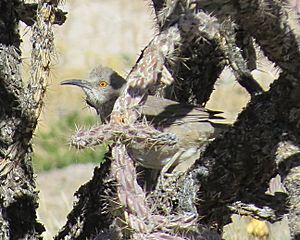
The fruits of the cane cholla are an important food source for many wild birds and mammals. Animals like pronghorn, desert bighorn sheep, and deer eat them. The thorny plants also provide a safe hiding place for many small animals, protecting them from predators.
A type of leafcutter bee called Lithurgus apicalis has been seen helping to pollinate the cane cholla flowers.
Uses of the Cane Cholla
People sometimes grow cane chollas as ornamental plants in gardens because of their unique look.
When a cane cholla stem dies and decays, it leaves behind a hollow, woody tube with a pattern of lengthwise slits. These dried stems are sometimes used as walking canes or to make interesting crafts and curios.
The Zuni people have used the imbricata variety of cane cholla in their traditional ceremonies.
Images for kids


